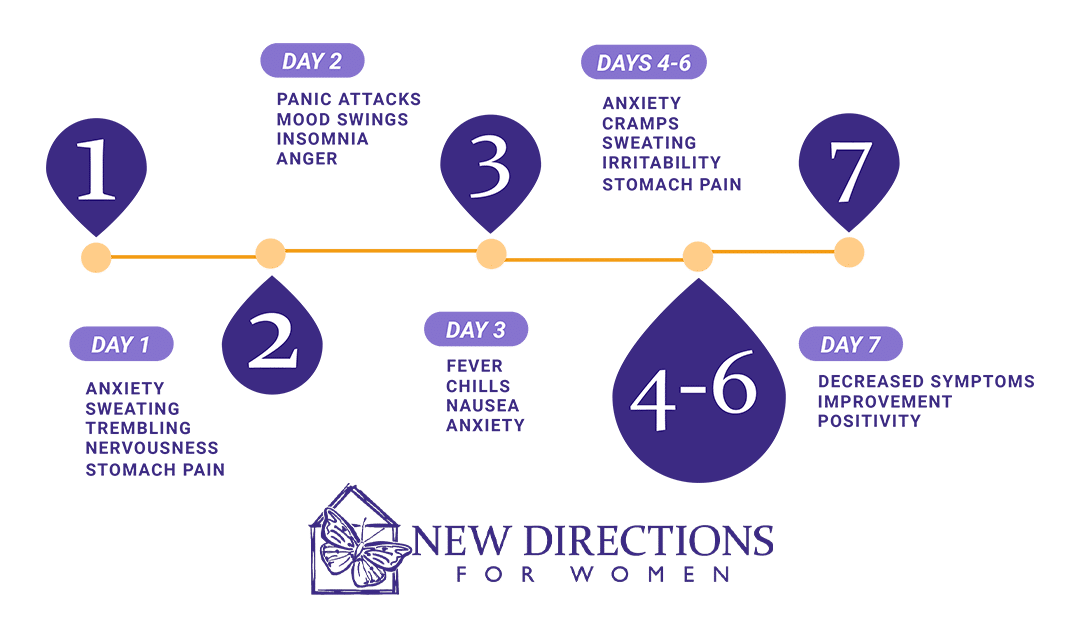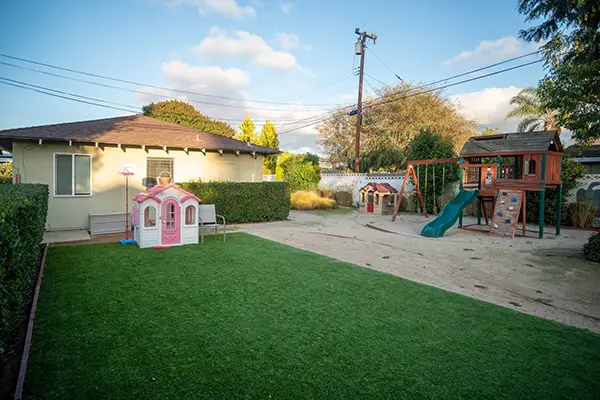Opiate addiction is a serious disease that affects every part of a person’s life. Opiates belong to a class of drugs that affect the nervous system. More specifically, they affect the pleasure and pain receptors.

Detox is the first step in recovering from opiate addiction. It’s the initial period of time when an individual stops using and the process by which a person flushes the body of opiates to cleanse the body of any drugs and toxins. By learning more about the opiate withdrawal timeline, you’ll be prepared for what to expect when you detox.
There are many steps in addiction rehabilitation, each one serving its own important service. While addiction recovery can be a long and scary process, each step brings you closer to sobriety. Detox programs are a safe way to withdraw from opiates and build a strong foundation for sobriety.
Opiate Withdrawal Symptoms
Opiate withdrawal from heroin, fentanyl, oxycontin, codeine and more all cause unpleasant withdrawal symptoms. Depending on the opiate that has been abused, symptoms of withdrawal experienced during the detox process will vary. Opiate withdrawal typically begins between six and 24 hours after the last time using and lasts between 4 and 10 days. Although less common, withdrawal symptoms can be experienced for up to a month.
The severity of withdrawal symptoms will depend on how often and for how long the individual used, as well as the number of opiates they were using at a time. Short-acting prescription opiates and long-lasting opiates may vary in withdrawal symptoms, but overall you can expect to experience some combination of the following symptoms:
- Severe anxiety, depression, and restlessness
- Headaches
- Nausea, vomiting, diarrhea
- Pain or soreness in the muscles and joints
- Difficulty regulating body temperature (hot and cold flashes)
- High blood pressure
- Fatigue
- Insomnia and hyperactivity
- General mood swings and discomfort
While these symptoms can be extremely uncomfortable, they have low chances of posing life-threatening risks. Being under the supervision of medically trained staff can further ensure any risks are mitigated before they cause any harm. It also gives you access to resources and tools that can decrease the severity of withdrawal symptoms, and help you cope better.
Opiate withdrawal is a difficult process. Although the experience will vary slightly from person to person, most cases follow a general timeline of symptoms and progress.
Day 1 of Opiate Withdrawal
The first day of withdrawal can be emotionally and physically taxing. While your body is confused and thinking it needs opiates in its system in order to function, the overwhelming emotional response to seeking help and starting a new life makes Day 1 intense.
 On Day 1, you should expect to have a full intake process with the staff of the detox facility. This means you will sit with your medical team and answer a series of questions that will help them better understand your addiction, and what would serve you best in a treatment program.
On Day 1, you should expect to have a full intake process with the staff of the detox facility. This means you will sit with your medical team and answer a series of questions that will help them better understand your addiction, and what would serve you best in a treatment program.
You will then be shown around the facility and given time to get comfortable in your new space. You’ll likely be beginning to withdraw upon entering the detox facility, so you should expect for uncomfortable symptoms to arise pretty quickly once you get to your treatment center.
Six to 24 hours after the last time using, you can expect to experience the following withdrawal symptoms:
- Anxiety
- Sweating
- Trembling and nervousness
- Stomach pain
Day 2 of Opiate Withdrawal
Day 2 will likely be similar to Day 1 of withdrawal but with a slight decrease in the feelings of being overwhelmed. By the second day, you should feel a little more comfortable with the staff and peers, as well as your living situation. It’s not uncommon to still feel out of your element or anxious, so don’t worry if you feel you haven’t made progress. Any time not using drugs or alcohol is progress.
On top of the symptoms from Day 1, you might experience these symptoms of withdrawal on Day 2 as well:
- Panic attacks
- Insomnia
- Anger or severe mood swings
Day 3 of Opiate Withdrawal
While you might think on Day 3 you should be feeling a bit better, it’s actually the peak withdrawal day for many people in the detox process. Many report that Day 3 is the most difficult day for them, both emotionally and physically.
The initial drive and acceptance of getting sober have probably worn off, and you are in the brunt of withdrawal symptoms, anxiety, and adjusting to being sober. You’re probably experiencing negative feelings of hopelessness and wanting to give up. This is why being in a clinical setting is so beneficial, you will have peers and staff to uplift and motivate you to keep going. You will likely experience the same symptoms as Days 1 and 2, but more intensely.
During this time, you will be talking with licensed psychotherapists and peers that are going through the same process, so you can feel more connected and understood. Treatments like one-on-one therapy and group therapy are an important addition to the detox process. Addressing the emotional aspect of addiction recovery will ensure you are able to form healthy coping mechanisms and avoid triggers.
Days 4-6 of Opiate Withdrawal

By Day 4, you should be adjusting to your surroundings and your body’s way of functioning without opiates in its system. You will still be experiencing withdrawal symptoms, but they will be less intense than Day 3. Emotionally, most people experience a slight improvement during days four to six, but everyone is different and shouldn’t compare their emotional experience to others. You can expect to experience some of the following withdrawals symptoms on days four to six of opiate detoxification:
- Sweating
- Stomach pain
- Muscle cramps
- Irritable mood
- Fatigue/Anxiety
Day 7 of Opiate Withdrawal
Day 7 is usually accompanied by a decrease in the severity of symptoms and an improvement in mood and outlook. By Day 7, the body is flushed of opiates and any residual toxins. You are likely developing new habits that are not associated with drug use, so the number of trigger moments will have gone down. You are building new neural pathways that stem from healthy habits.
From a chemical level, your brain is beginning to produce “feel good” signals on its own again, and the anxiety and deep craving for opiates will have subsided. It’s very normal to still feel some residual withdrawal symptoms. Feelings of anxiety and depression can linger for weeks. Some people experience an extended duration of physical pain and gastrointestinal distress.
Just as no two addictions are the same, neither are recovery. In most cases, Day 7 and on will only bring about improvements both mentally and physically. It’s important to inform your medical team of any symptoms you are experiencing so they can extend or adjust your treatment program as needed.
What Happens After Detox?
Recovery doesn’t stop after detox. It is the most important step because it builds the foundation for the rest of your treatment program, but it’s crucial to continue aftercare and dedicate yourself long-term to sobriety. Continuing your journey with medically trained staff will ensure you are receiving the support, resources, and knowledge you need to achieve long-term sobriety.
Once detox is complete, you will have an option of attending either a residential or outpatient treatment program. Both will offer a variety of treatments and services that will keep you on track with your progress and help you build the skills to be able to adjust back into normal life without the worry of relapse.
Facilities offer multiple types of ongoing programs so that you can find one that suits your lifestyle and needs. Professionals know the importance of aftercare, so speak with your team about whether an inpatient residential treatment program or a long-term outpatient program is best for you.
Studies have shown that those who enter long-term treatment after detox are less likely to relapse. Both inpatient and outpatient treatment programs can offer you the following:
- Cognitive behavioral therapy with licensed professionals
- Group therapy with peers in your program
- Nutritional therapy
- Life skills workshops
- Various classes and meetings on sobriety
- An environment with support and like-minded people
- Alternative healing methods such as yoga, meditation, and acupuncture
- Professional support, supervision, and mentors
- Resources to help you rebuild your life after leaving the program
When building a treatment program, you should think of both detox and long-term treatment as part of the process. Both offer important tools and steps to achieving long-term sobriety.
Find Help for Opiate Cravings at New Directions for Women
New Directions for Women welcomes all women looking to get help for their addiction. Our specialists are trained and experienced at helping women from all walks of life overcome addiction and rebuild their lives. We treat each patient individually and holistically, making sure every aspect of their lives is addressed and accounted for when designing a treatment plan.
Our detox program for women will ensure you build a strong foundation that will help you stay sober for life. For more information, contact us anytime. We are excited to help you start your journey to the life you deserve.



